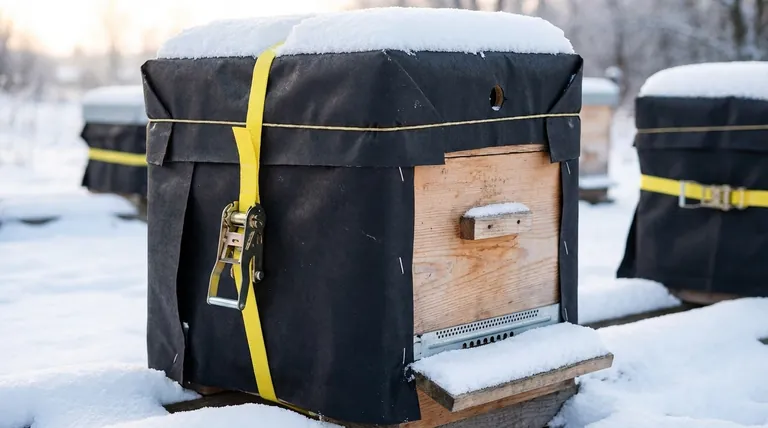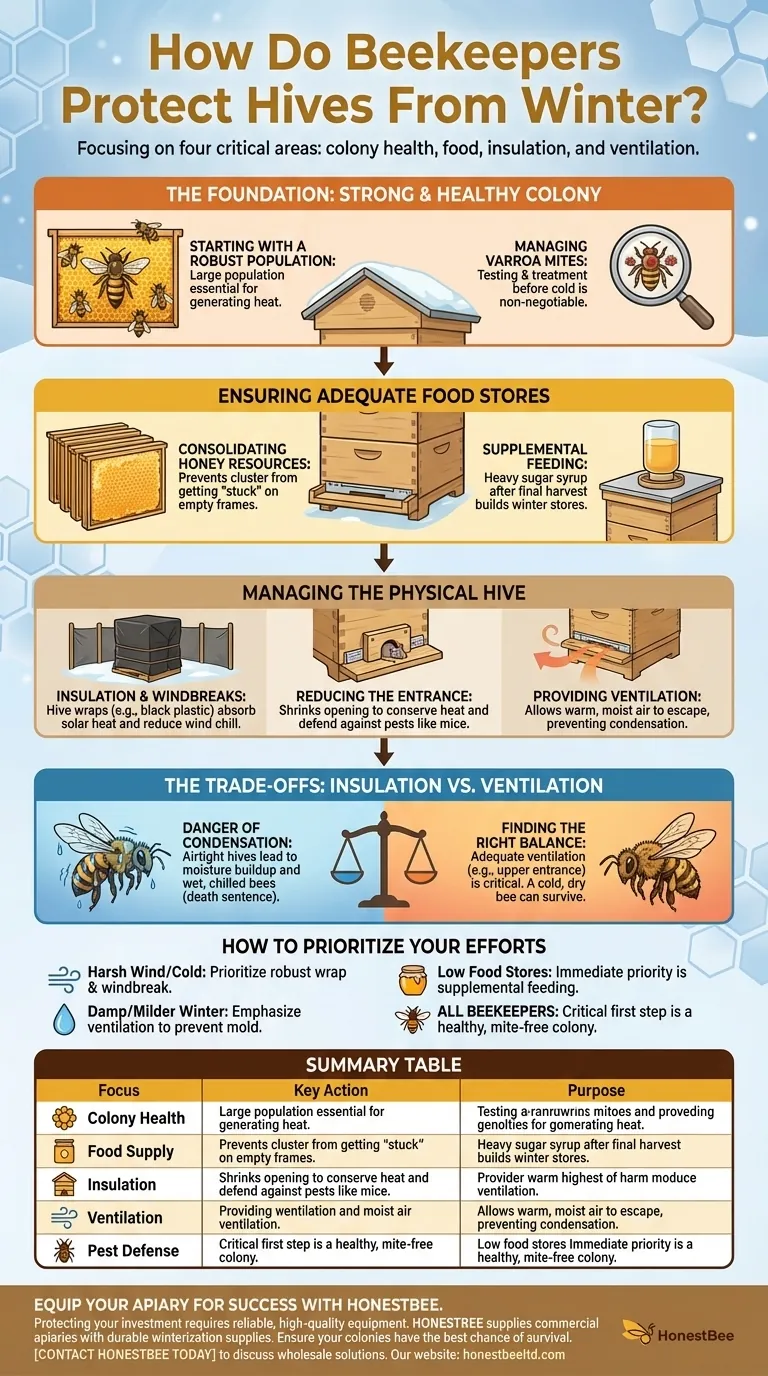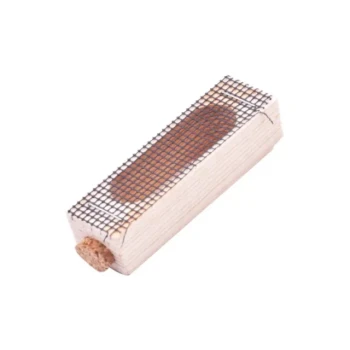To protect a beehive through winter, a beekeeper’s strategy focuses on four critical areas: ensuring the colony has ample food, insulating the hive against wind and cold, providing ventilation to control deadly moisture, and fortifying the hive against pests like mice. This preparation begins in the late summer and fall, as a strong, healthy colony is the essential foundation for survival.
The primary goal of winterizing a hive is not to keep it warm, but to create a stable, dry, and secure environment. The beekeeper's job is to manage external threats so the bee colony's natural survival behaviors—clustering for warmth and consuming honey for energy—can succeed.

The Foundation: A Strong and Healthy Colony
Before any physical preparations are made to the hive, the colony itself must be robust. A weak or diseased colony is unlikely to survive winter, regardless of how well the hive is insulated.
Starting with a Robust Population
A large population of bees is critical for generating sufficient heat within the winter cluster. Beekeepers focus on ensuring colonies are strong and healthy throughout the late summer and fall to maximize the number of bees entering the winter period.
Managing Varroa Mites
Varroa mites are a primary threat to honey bee health. A colony weakened by a mite infestation in the fall will have a significantly reduced chance of winter survival. Proper varroa testing and treatment before the weather turns cold is a non-negotiable step.
Ensuring Adequate Food Stores
Starvation is one of the leading causes of colony loss during winter. Bees do not hibernate; they actively generate heat by consuming honey, and they need a substantial supply to fuel them for months.
Consolidating Honey Resources
Bees form a tight cluster that moves throughout the hive to access honey. Beekeepers will often arrange the honey frames so they are consolidated in one area, ensuring the cluster does not get "stuck" on an empty frame and starve, even with food just inches away.
Supplemental Feeding
After the final honey harvest, beekeepers often feed colonies a heavy sugar syrup. This allows the bees to build up their winter stores without the beekeeper having to leave the entire season's honey crop in the hive.
Managing the Hive's Physical Environment
Once the colony's health and food are addressed, the focus shifts to modifying the physical hive structure to protect it from the elements.
Insulation and Windbreaks
To help the bees regulate temperature more efficiently, many beekeepers wrap their hives. A common method is using black plastic or tar paper, which serves as a windbreak and absorbs solar radiation to add a small amount of warmth on sunny days. Other insulation materials can also be added to the hive bodies.
Reducing the Entrance
A large hive entrance is a source of heat loss and a security vulnerability. Beekeepers install an entrance reducer, a small piece of wood that shrinks the opening. This makes it easier for the bees to defend against intruders like mice seeking a warm place for winter. Often, a "mouse guard" made of hardware cloth is also installed.
Providing Ventilation
While insulation is important, ventilation is arguably more critical. As bees consume honey and respire, they release a significant amount of warm, moist air. Without a way to escape, this moisture will condense on the cold inner surfaces of the hive and drip down onto the cluster, which is a death sentence for cold bees.
The Trade-offs: Insulation vs. Ventilation
One of the most common mistakes is to focus solely on keeping the hive warm. The true challenge lies in balancing insulation with the critical need for airflow.
The Danger of Condensation
A sealed, airtight hive is a death trap. The moisture produced by the bees will lead to condensation, moldy equipment, and wet, chilled bees. A cold, dry bee can survive; a wet, cold bee will die quickly.
Finding the Right Balance
To combat moisture, beekeepers ensure there is adequate ventilation. A common and effective method is to create a small upper entrance or crack in the hive cover. This allows the warm, moist air to escape, preventing condensation from forming directly above the bee cluster.
How to Prioritize Your Winterization Efforts
Your specific actions will depend on your climate and your colony's condition, but the principles remain the same.
- If your primary focus is mitigating harsh wind and extreme cold: Prioritize a robust hive wrap and a solid windbreak to reduce the energy your bees must expend.
- If your primary focus is managing a damp, milder winter: Emphasize ventilation and moisture control above heavy insulation to prevent condensation and mold.
- If your colony's food stores seem low in the fall: Your immediate priority must be supplemental feeding to prevent winter starvation.
- For all beekeepers, regardless of location: The most critical first step is ensuring you have a strong, healthy, and mite-free colony going into the fall.
Ultimately, successful wintering is the result of proactive management that empowers the bees' own remarkable ability to survive.
Summary Table:
| Winterization Focus | Key Action | Purpose |
|---|---|---|
| Colony Health | Varroa mite testing & treatment | Ensure a strong, disease-free bee population. |
| Food Supply | Consolidate honey frames & supplemental feeding | Prevent starvation; provide energy for heat generation. |
| Insulation | Hive wrapping & entrance reducers | Reduce heat loss and protect from wind. |
| Ventilation | Create upper entrances | Control deadly moisture buildup and condensation. |
| Pest Defense | Install mouse guards | Fortify hive against winter intruders like mice. |
Equip Your Apiary for Success with HONESTBEE
Protecting your investment through winter requires reliable, high-quality equipment. HONESTBEE supplies commercial apiaries and beekeeping equipment distributors with the durable supplies needed for effective winterization, from robust hive wraps and entrance reducers to essential feeding supplies.
Ensure your colonies have the best chance of survival. Contact HONESTBEE today to discuss our wholesale-focused solutions tailored for large-scale beekeeping operations.
Visual Guide

Related Products
- Professional Galvanized Hive Strap with Secure Locking Buckle for Beekeeping
- Professional Bamboo Queen Isolation Cage
- Professional Grade Foldable Beehive Handles
- Black Plastic Beetle Barn Hive Beetle Trap for Beehives
- Professional Drop-Style Hive Handles for Beekeeping
People Also Ask
- What are hive straps and why are they used? Secure Your Hives Against Wind, Predators, and Transport
- Can straps with hook ends be used for beehives? A Guide to Secure Hive Management
- What are the two styles of hive straps? Choose the Right Strap for Your Hive Security
- Why are hive straps important for beekeepers? Secure Your Hives Against Wind, Predators & Transport
- What is the best length for straps used around beehives? Why 12 Feet is the Industry Standard



















